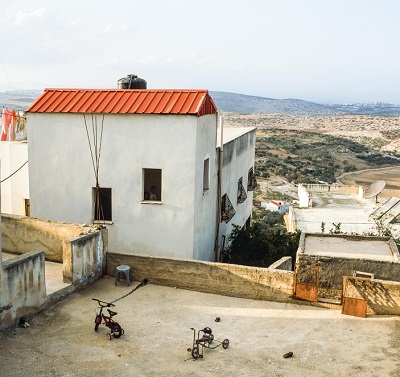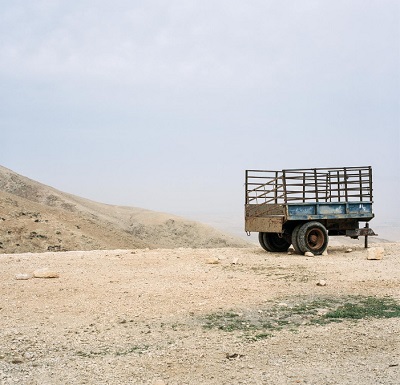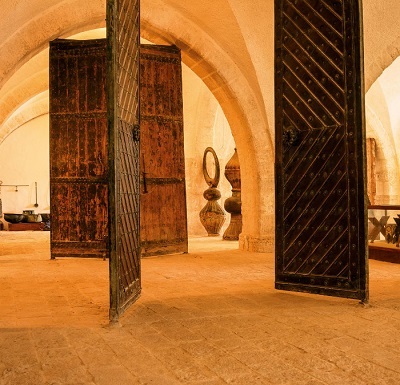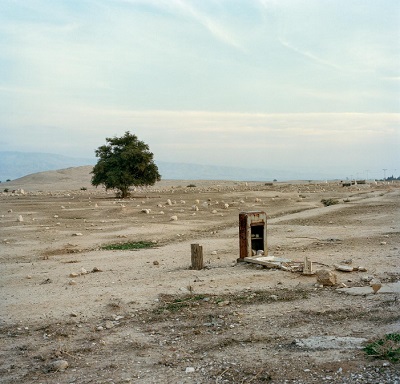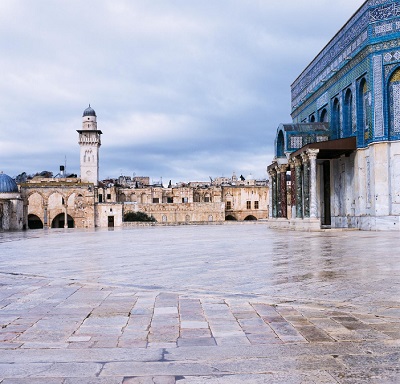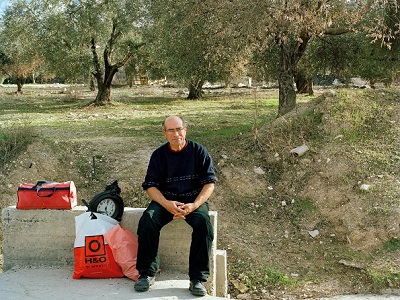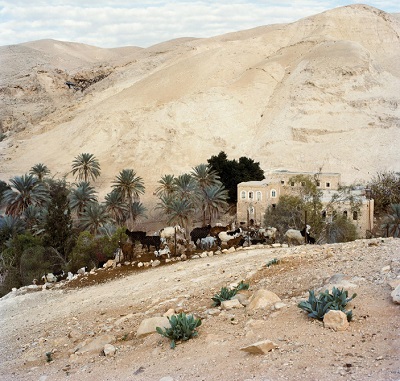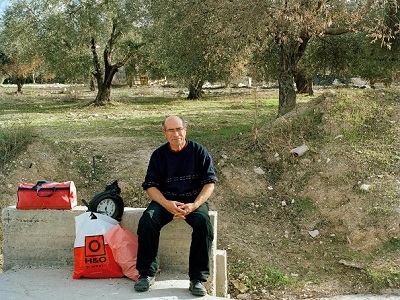
“The Palestine I visited remained elusive, transfixed in the stillness of its own time. I felt almost like an intruder as I approached the contradictory present topography and demanding past contained within: places of great weight and history, places of many recorded and unrecorded memories, places resonant with human suffering and dignity”
By Rachael Pells
Travelling along Route 60, a long main road crossing the entire West Bank, Federico Busonero came across a middle-aged man. Sitting among a number of red bags with a large, stopped clock, he seemed to be waiting for someone – but he did not speak English and Busonero did not speak Arabic.
“I asked him if I could make a photograph, pointing the camera to him,” explains Busonero. “He did not refuse and looked straight at me.”
During the 15 minutes Busonero spent sitting with the stranger, the time on the clock didn’t change. “The man also did not move,” says the photographer, “his hands crossed on his legs, pensive eyes looking at me. Everything was halted.
“For me the photograph is a metaphor of the condition of all Palestinians: their time is frozen, they cannot move, they wait for a solution which only the external world can give them: the end of the occupation, the return to normality, the freedom to live and to cultivate their own land, the land that remains.”
Commissioned by UNESCO, Busonero made three extensive photographic journeys throughout the West Bank of the occupied Palestinian territory in 2008 and 2009. During his assignment, he preferred to travel alone to avoid the inevitable limitations of the escort offered for safety. Using a pass issued by the United Nations, he was still able to photograph places not usually open for access due to the Israeli occupation, often ending up in isolated villages and unmarked desert areas.
The image of the roadside stranger is one in a series published in his resultant book, The Land That Remains.
Taken with a traditional film camera, Busonero’s images come from a politically neutral perspective, his sole intention being to present what is left of the ancient, solitary land. “My approach to Palestine was the same as anywhere,” he explains. “Whenever I start a project, either commissioned or my own, I first visit the place without carrying my camera. I usually return to the place several times until it becomes familiar and reveals itself.
“I must listen to the place,” he continues. “Photography is about waiting, and cultivating time. Time to develop the necessary attention and perception of the subject, of what exists or existed there beyond the instant of seeing.”
Insights into rarely seen places and vanishing archaeological sites encourage a form of what he calls a “meditation on the land”. But while many of the landscapes pictured may appear peaceful at first glance, the reality is far different. As Busonero says, “they convey a persistent disquiet and anxiety. They do not show the abused imagery of the war and the brutality of the Israeli occupation on the population; rather they portray the consequences of this occupation on the land which is rarely seen and considered.”
Busonero calls his images “an elegy for a region which is vanishing, a region of unbearable beauty and pain. For me, the two images of Wadi Qelt [pictured] portray the complexity of the landscape of Palestine, its deeply contradictory topography, the past and the present in reckless and profound opposition, the beauty of this land and the crude necessity of today.
“The shepherds and their herd on the flank of another wadi south to Taybeh seem lost in a vast landscape. The photograph is an elegy, an effigy. It is about time and space – the eternity of a millennial landscape where nomadic shepherds used to live and attend their herds.”
Travelling through the occupied territory of the West Bank, Busonero rarely encountered people, because they can only travel with Israeli Army permits. But for the photographer it is the land that is the subject of his research, since “the land is not usually seen and because the Palestinian people inhabit an absence. Their land has been taken away. The woman at the end and the man at the beginning of the book tell us this.”
“Photographs suggest relationships. The more they suggest the more they are evocative and powerful. They do not show one subject but how this subject – a person, a place, a landscape – is related to other things either real or imagined.”
Although the sequence ends with the portrait of a woman in Al’Numan, a small village situated between Jerusalem and Bethlehem, “the photograph which follows the last text indicates how the boys and girls of a school in Sabastiya, a village near Nablus, perceive the land where they live, a land which no longer exists.” Except, as he says, on a map.
“I felt loneliness everywhere. I travelled most of the time alone, through a land which is alone. I was almost overcome by the sheer vastness of the desert, the cemeteries, the remains of the great history and the violence of the actual. But I also felt beauty.”
(This article was first published in the Independent newspaper, UK, and is republished in the Palestine Chronicle with permission from the author.)
– Federico Busonero is an Italian photographer currently based in the Pacific Northwest. His book, ‘The Land That Remains’, is available to purchase from Hatje Cantz publishers and his website.

